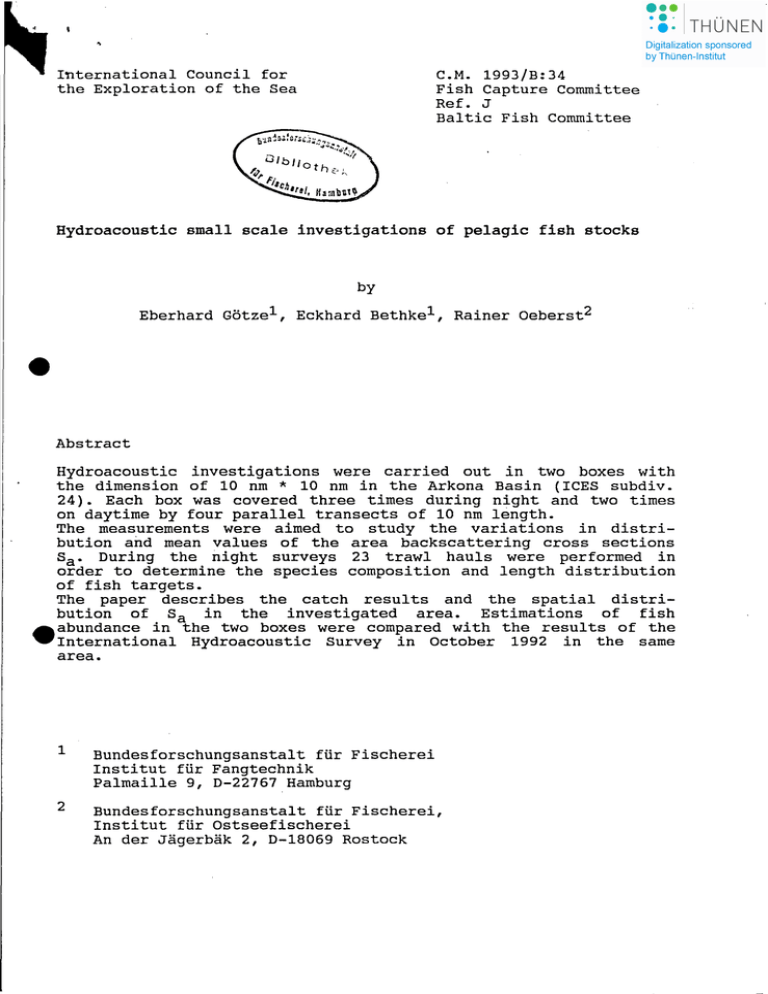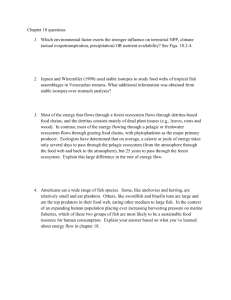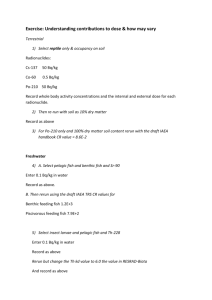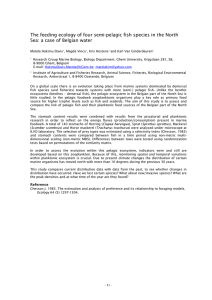International Council for C.M. 1993/B:34 the Exploration of the Sea Fish Capture Committee
advertisement

International Council for
the Exploration of the Sea
C.M. 1993/B:34
Fish Capture Committee
Ref. J
Baltic Fish Committee
Hydroacoustic small scale investigations of pelagic fish stocks
by
Eberhard Götze 1 , Eckhard Bethke1 , Rainer Oeberst2
•
Abstract
e
Hydroacoustic investigations were carried out in two boxes wi th
the dimension of 10 nm * 10 nm in the Arkona Basin (ICES subdiv.
24). Each box was covered three times during night and two times
on daytime by four parallel transects of 10 nm length.
The measurements were aimed to study the variations in distribution and mean values of the area backscattering cross sections
Sa. Ouring the night surveys 23 trawl hauls were performed in
order to determine the species composition and length distribution
of fish targets.
The paper describes the catch results and the spatial distribution of Sa in the investigated area. Estimations of fish
abundance in the two boxes were compared with the results of the
International Hydroacoustic Survey in October 1992 in the same
area.
1
Bundesforschungsanstalt für Fischerei
Institut für Fangtechnik
Palmaille 9, 0-22767 Hamburg
2
Bundesforschungsanstalt für Fischerei,
Institut für Ostseefischerei
An der Jägerbäk 2, 0-18069 Rostock
2
1.
•
Methods
The pelagic fish shows a distinct day night behaviour. At day-time
it formssolid shoals close to the ground. During the dusk the
shoals disintegrate and at nighttime the fish is more or less even
distributed in the·whole pelagic region. Fig. 1.2 shows this
behaviour in quality by means of echograms.
The investigations were carried out in two rectangular boxes, each
of 10 x
10 nm 2 •
The boxes were consecutive surveyed by
hydroaeoustie as weIl as hydrographie measurements and by fishery.
The position of the boxes was chosen in a previous hydroacoustie
survey and seleeted aeeording to the maximum fish density and the
hydrographie eonditions. Figure 4.1. shows the position of the
boxes. Eaeh box was eovered 3 times at night and 2 times at day.
Box A was investigated in the time from November 4 to 8 with a
break of teehnieal reasons from November 6 - 7. Box B was eaptured
in the period from November 8 to 10.
Bydroacoustic: For the hydroacoustic measurements the echo-sounder
system· EK500 with a working frequency of 38 kHz was used. The
transdueer 38-22 was mounted in a towed body to reduee fish
reaction caused by the ship noise. The transects within the boxes
were parallel with a distanee of about
2.5 nm. The averaging
distanee along the measuring course was adjusted to 0.1 nm.
The Sa-values were recorded on harddisk in 50 layers of 1 m length
in the surface referenced mode and in 20 bottom refer-eneed layers
with the same length. The high resolution was neeessary on one
hand for an evaluation in detail, but also for the cleaning of the
data fro~ interferences of plankton and echoes from the bottom.
Bydrography: After each haul a hydrography station was carried
out; With a storage probethe temperaturej conductivity and the
pressure was measured and the salinity and the density was calculated. Fig. 1.1 shows typical temperature profiles in this area.
The depth of the thermocline showed a high variability in time and
changed from 30 to 37 m.
Fishing: Fishing was done only at night due to working time
regulations. The pelagic trawls were carried out with the trawling
gear "Kabeljaubomber" •. For ground trawls the trawling gear
"Aalhopser" was used. Both nets had 10 mm mesh size in the cod
end. The trawling time was 30 minutes. Per hydroacousic transect
there was made one hau1 to determine the speeies eomposition and
length distribution of the targets.
2
Horizontal distribution of Ba values
The area backscattering cross section Sa was investigated on
south-north transeets. Figure 2.1 shows the distribution of total
Sa-values along transect 1 in box A measured during night on
•
•
3
,•
November 4th. The transect started on latitude 54° 44'N in the
shallow part of the area and lasted until 54° 54'N in the deeper
part of Arkona Basin. Results fram the same transect measured next
day are depicted in fig. 2.2. At daytime the fish was concentrated
in single shoals. This behaviour leads to a higher degree of
variation in sa values than in the more even distributed night
concentrations. The general trend was quite similar in the deeper
region north of 54° 48'N. A stronger disagreement appears in
shallow water areas especially near the 40 meter depth line.
Th~ variations in Sa night distributions on the same transect in
box A during the time period from November 4 - 7 are demonstrated
in fig. 2.3; The averaging interval was chosen to 0.5 mile in
order to show the trend without short fluctuations. The strong
increasing in the later surveys was observed in the hole area of
box A . ,
'
An overview on spatial distributions of Sa from different surveys
in box A is given in fig. 2.4. The upper part shows the results of
night surveys while in the lower part daytime investigations are
depicted. The values are averaged over 2.5 nm on the transects and
the mean Sa is indicated foreach lin~ and column.
In box B the situation was also characterised by a high degree of
variation in the horizontal distribution of Sa.
3.
Vertieal fish distribution
By the
determination of Sa as a measure of the fish density by
the echointegrator, it is possible to analyse the effect of
vertical migration in quantity. For the representation of vertical
distribution the Sa-values of the severaldepth has been sorted by
recording time and water depth and then averaged. The,daytime data
eonsist of the readings taken from 10-14 o'elock while the
nighttime data were recorded between 22 o'clock and 02 o'clock.
The transition periods found no eonsideration. The fig. 3.1, 3.2,
3.4 and 3.5 are showing the vertieal daytime, and nighttime
distributions of Sa respectively of box A and box B. Note that the
' data of fig., 3.1, 3.2, 3.4 and 3.5. are related to the, bottom (the
• maximum depth is on ,the left side) while ,the,data of fig. 3.3 and
3.6 are related to the surface (the maximum depth is on the right
side). From the upper figure it, is evident, that during daytime
the fish was concentrated below the thermocline elose to the
grourid.
Betweeri bottom, and the lowest layer a death zone occurs. The fish
is overlapped by the bottom echo and for that reason aseparation
from the ,bottom echo is not possible. The supposition is obvious
that a big part of the biomass was included in the death zone;,
This fact leads to an error of measurement of course.
The fig. 3.3 and 3.6 are showing the differences between day and
night Sa-~alues versusthe water depth. Only close to the ground
and at the occurrence of big schools in the pelagic region the Savalues are higher at daytime than that at night.
The fig. 3.7 shows the night-day-ratio ofthe total Sa versus the
depth. In the shallower areas the night values had a streng
variation and were sometimes eensiderable higher, while iri the
4
deeper areas the night-day-ratio is between 1 and 3. Therefore at
daytime the biomass will be underestimated in shallow areas. In
the deeper areas the correction of the day values seems to be
possible.
4.
Results of the trawl hauls
A total of 23 trawl hauls were made during the survey, 13 pelagie
trawl stations and 10 stations with the bottom trawl. The
positions of the trawl stations and the catch eompositions of the
main species herring and sprat are depicted in fig 4.1. The catch
resul ts per half an hour trawling time are surnrnarised in table
4.1.
The water eolumn was separated into two parts by a diseontinuity
of temperature which was found in depth of 30 to 37 meters. Both
layers were investigated by pelagic or ground hauls. The cateh
ratio of the main species of box A is presented in table 4.2. The
proportions were different in the separated layers but independent
of depth. The variability of the proportions was low.
Table 4.3 shows the results of box B. In eontrast to box A there
was no herring in the upper layer. The results of the two layers
differ in the proportions of the age group zero of sprat~ Only low
numbers were found in the hauls in the upper layer. In the layer
below the diseontinuity the proportion of sprat of age group zero
inereased with the catch in number of this age group.
Within the layers the proportions of the main species were
independent of depth and the variability was also low.
5
•
Estimation of fish abundance
The calculations were made in two different depth layers separated
by the mean depth of thermoclinej one layer covered the upper 30
meters the other one the lower part fram 30 meter depth to the
bottom.
The estimation of abundance was based on the mean values of Sa and
backscattering cross section .of the targets in the whole box for
each survey. The backscattering cross section of thc "mean" fish
in the stratum was calculated according to species compositions
and length distributions from trawl hauls in the layer concerned
using the TS-length relations:
TS
TS
=
=
20 log L (ern)
70.8 dB
20 log L (ern) - 67.5 dB
(Lassen & Staehr, 1985)
(Foote, 1985)~
Trawl results were available only for night surveys. TS values and
species compositions for the daytime surveys were supposed as the
mean value fram the previous and next night trawling.
The total number of fish in the two depth layers was allocated to
the main speeies herring and sprat - both speeies divided in 0
group and 1+ group. Estimation results are surnrnarised in table 5.1
and 5.2 for box A and B respectively~
The abundanee of fish in the lower layer was rather similar in all
•
5
surveys while the abundance in the upper layer shows strong
fluctuations and caused the great difference in fish abundance
between box A and B. This situation is presented in fig. 5.1 and
5.2.
It may be of interest to compare these results with the abundance
of fish determined during the International Hydroacoustic Survey
in the Baltic in October 1992. On this survey in ICES square 3857
- this square includes the two boxes - a mean fish density of 3.65
millions fish per square mile was estimated. The mean value of
fish density over all surveys in box A and B is 3.69 millions per
square mile. Of course, the agreement of this numbers is a pure
chance.
6.
Conclusions
During the investigation a strong variability of day and night Savalues was found. In the shallow areas the night values were
. . generally considerable higher, while in the deeper areas the
night-day-ratio was low. The results are doubtful if the daytime
S -values in shallow water areas are used for the estimation of
t~e biomass. Therefore hydroacoustic measurements at daytime in
sha110w water regions are not recommended. In the deeper areas the
correction of the day values seems to be possib1e, but a constant
factor can't be given.
The spatia1 distribution of the Sa-values shows a high degree of
variation in time. Therefore a short survey time is necessary to
get a synoptic picture of the real fish distribution.
The species composition
and the density distribution is strong
re1ated to the depth. The
thermocline forms a boundary for the
1iving areas of different fish concentrations. Therefore a depth
stratification is recommended to get better estimates of fish
abundance.
References
Foote,K.G., Ag1en,A. and Nakken,O. (1986). Measurement of fish
target strength with a split-beam echosounder. - J. Acoustic. Soc.
Am. 80(2): 612-621
Lassen,H. and Staehr,K.~J. (1985). Target strength of
herring and sprat measured in-situ. - ICES C.M. 1985/B:41
ba1tic
Oround Hau!..
P",lagi., Haui..
BoxA
23
24
27
Sprattus sprattus
1.6
16.6
Clupea harengus
10.7
42.8
Gadus morhua
0.9
2.5
Merlangius merlangus
0.1
0.7
Fish species\Haul-Nr.
34
25
26
28
31
33
30.0
53.6
86.5
63.8
74.5
75.5
44.6
549.0
98.4 155.2
17.9
1.3
3.3
0.5
6.7
4.5
496.7
2.9
7.5
4.7
16.2
12.0
12.0
64.5
1.2
1.8
8.0
1.1
8.2
3.3
26.8
5.2
6.2
14.8
3.4
12.9
10.5
29
30
32
31.9
28.6
41.8
56.2
99.2
2.9
2.9
2.1
0.3
Platichthys flesus
2.0
Pleuronectes plat
8.3
Lotalota
1.5
1.9
1.1
5.2
0.8
1.9
0.5
Pomatoschistus minutus
+
Gasterosterus aculeatus
0.1
0.2
1.4
. 1.2
+
0.1
0.1
0.3
0.5
3.0
2.0
0.3
0.1
0.3
+
0.1
0.5
+
1.0
Psetta maximus
Stizostedion lucip.
1.2
1.3
3.5
0.2
0.2
Trachurus trachurus
8.6
1.4
+
Anguilla anguilla
0.1
+
0.1
0.5
1.2
1.7
Pollachius virens
0.0
0.0
Cyclopterus lumpus
+
Zoarces viviparus
Umanda limanda
0.5
0.5
0.2
0.2
+
Scomber scombrus
+
Soleasolea
+
Osmerus eperlanus
+
Ammodytes spec.
+
13.4
total
62.8
91.3 133.2 140.9 185.2
Pelagic Hauls
BoxB
Fish species\Haul-Nr.
35
Sprattus sprattus
87.8
G1upea harengus
18.8
Gadus momua
37
Merlangius merlangus
0.5
0.5
Pleuronectes plat
38
40
43
45
36
39
41
22.0 152.1
146.1
36.4
5.0
80.6
48.8
5.6
16.4
5.2
6.3
3.0
6.7
0.9
1.3
0.4
0.3
0.2
0.1
0.4
Lotalota
Pomatosehistus minutus
+
Gasterosterus aeuleatus
+
1.5
Trachurus trachurus
0.8
0.6
+
+
99.0 116.7
7.6
0.2
+
+
+
1.0
total
755.9 1304.9
42
0.2
1.1
0.2
0.2
58.6
555.3
16.2
27.9
8.0
32.1
99.4
163.9
17.1
1.6
1.9
6.7
9.8
39.5
66.3
3.4
5.8
13.8
8.4
6.5
38.4
53.2
1.1
1.3
1.3
4.1
17.0
0.5
1.6
0.8
0.4
0.4
3.7
14.2
0.8
0.6
0.3
0.7
0.6
3.2
11.8
0.1
+
004
9.6
11.0
0.5
2.2
2.7
6.2
0.3
1.0
3.8
0.4
0.8
Pollaehius virens
44
61.9 109.6
0.5
Anguilla anguilla
2.3
0.7
0.2
1.0
1.8
Cyelopterus lumpus
0.2
0.2
0.5
Zoarces viviparus
0.1
Umanda limanda
+
Seomber scombrus
0.1
Soleasolea
+
Osmerus E'perlanus
Ammodytes spec.
total
Table 4.1:
108.4
75.3 1191.4
13.2
Psetta maximus
Stizostedion lueip.
86.6
Ground Hauls
0.7
Platichthys flesus
75.9 111.1
•
29.3 167.8 164.4
42.2
13.2 121.5
78.0
55.6
6.0
6.2
5.1
5.2
1.8
3.5
1.8
1.8
0.9
0.9
0.1
0.6
0.0
0.2
0.1
0.1
+
+
+
+
+
+
89.8 160.7 1030.9 2222.3
Catch composition in kg 10.5 hour tor box A and box 8
•
•
•
Night
Ha.ul typ
Number
HEO
HE1
SPO
SP1
1
2
3
pelagic
pelagic
pelagic
2
3
2
24.0
14.7
7.0
15.1
7.9
25.0
25.0
19.5
23.4
11.2
14.0
23.0
30.0
22.4
10.4
27.5
33.7
42.0
34.0
10.3
ground
ground
ground
2
1
2
0.0
0.0
1.0
0.4
1.0
0.0
0.0
0.5
0.2
0.4
18.5
4.0
2.5
9.2
11.3
58.5
64.0
69.0
63.8
17.7
Mean
Standard deviation
1
2
3
Mean
Standard deviation
Table 4.2: Catch in proportion of the main species of box A
•
Night
Haultyp
1
pelagic
2
pelagic
3
pelagic
Mean
Standard deviation
ground
ground
ground
1
2
3
Number
3
1
2
HEO
0.3
1.0
3.5
1.5
2.3
HE1
1.3
1.0
5.5
2.7
4.1
SPO
34.7
20.0
35.5
32.5
11.4
SP1
48.3
78.0
50.0
53.8
18.4
1
3
1
0.0
0.3
0.0
0.2
0.4
0.0
0.0
0.0
0.0
0.0
2.0
6.0
2.0
4.4
2.5
78.0
60.0
78.0
69.2
21.2
ANS
425.7
2.13
36.9
62.8
57.7
84.6
262.3
1.81
0.0
0.0
7.3
116.2
AN7
466.0
2.18
16.3
45.3
69.7
97.6
433.0
2.13
2.2
1.1
5.5
152.8
A08
132.0
2.18
4.2
11.8
18.1
25.4
524.0
2.13
2.5
1.2
6.2
169.8
8010
120.8
1.55
1.7
2.5
21.6
49.7
492.8
2.12
0.3
0.0
9.3
172.3
8N10
756.5
1.56
16.9
26.6
171.8
241.9
Mean
Standard deviation
Table 4.3: Catch in proportion of the main species of box 8
Layer
0-30m
•
30m-bot.
Sa
TS
NHeO
NHe1+
NSpO
NSp1+
Sa
TS
NHeO
NHe1+
NSpO
NSp1+
AN4
236.8
2.3
26.9
28.0
15.7
30.8
215.2
1.46
0.0
0.0
29.7
94.0
A05
51.6
2.22
4.5
5.8
4.3
7.1
228.4
1.64
0.0
0.0
15.7
85.5
Tab 5.1 Estimated numbers (millions) of main species in different layers in box A
Layer
0-30m
30m-bot.
Sa
TS
NHeO
NHe1+
NSpO
NSp1+
Sa
TS
NHeO
NHe1+
NSpO
NSp1+
8N8
638.9
1.22
1.6
6.8
181.8
253.1
335.0
1.79
0.0
0.0
3.7
145.9
809
328.8
1.38
1.5
2.7
65.1
150.3
173.5
2.02
8N9
585.8
1.54
3.8
3.8
75.9
295.9
502.3
2.26
0.1
0.7
0.0
3.4
59.2
0.0
13.4
133.6
Tab 5.2 Estimated numbers (millions) of main species in different layers in box 8
512.0
1.98
0.0
0.0
5.2
228.1
•
•
11 ,-;:===========;------------------::.,~:--I
.-.::-::,:,"~ ~
":
.
."
10,5 "
.
.
.
10 '
........................_
ü0
ci.
E
9,5
.
........••...................
.....
Q)
0_
9
••••••••••
.-
..
-_:-- -"
......................... -
\
-
\
..............
'~
8,5 ......._
8
_
0
5
10
15
············f······· ··········i·······················
. . , . . _-..,/' -----.. . . . --S.
_
__
.
~
.
.
'~'..
_
20
25
........
•
_--~._-
30
..:,;.
I
.:.::::.~_
•
.. _ __.•...............
35
40
45
depth (m)
Fig. 1.1 Temperature profiles in box A on 5 November 1992
I ..,..,.;,; ";lf
<I' ~ilr
1i •
'l
".
.":'-':'''l,'
""'.
I.
,
I.~.:;r,;;:'f
••• ~'
" ..
u-
J.
I
~:;. ~4 ~~f~ 1ifi.; ~«
.
:
.".,
:~ .:..
;
:..
'.
....'l,;
~"'
...
~
I
,I.
I
•
I
7)t ;:~.,," ":"',,:-,1:,- ".r>~,; ~'~'I--:;;;.
, '.
", ",
,
. I
0,"
"
....
'
..
"
"
~/v
Day
Dusk
Night
Fig. 1.2 Typical echotraces of fish concentrations during the survey
•
,
#
1400,-----------y--------------------,
1200
.
1000
.
_
_
.
.
800
600
400
200
O-+---~---:--.-----:--.----.....----r-----.-----.----..-----..-----l
5444
5445
5446
5447
5448
5449
5450
5451
5452
5453
5454
Fig. 2.1 Sa distribution on transect A1 during night survey
•
1400....-------------------------------,
1200
_
1 000
_
800
_
600 .._
_
-._._
-
_
_
_
_
_.._
_
_
_.._ _
_.._
_.................... ._
_...
_-
_
.
.
_
_ __
_
.
_.._
.
.
.
_ _..... .
400
200
5445
•
5450
5448
5451
5452
5453
5454
Fig. 2.2 Sa distribution on transect A1 during the next day survey
1400
5444
5445
5446
5447
5448
5449
5450
5451
5452
5453
Fig 2.3 Variations in the Sa distribution of transect A1 during different night survey
Sa distribution during night
8.no\l,
. ,~~~-~~:~~ . . ._.__.~~ I::::~:~:::::::::::::::::::::::::~::::~::
20
18
~
.
16
t
.
14
10
8
6
4·
2
VI
2&4
Sa distribution during day
Fig. 2.4. Spatial distribution of Sa mean values in box A
•
'"
.
."
•
#
Lnyor Sa-valuo..
r
'f ..
•
•J
.
]1-
Watordopth
_"2m
."'.
....
~"ll:-
. 3 9 rn
.38m
.37"",
.3..
. 3 6 rn
.3'5 rn
~~q:
I . "
.32"'"
t
01
rn
.3'3 rn
100
SOl
"'
. 4 0 rn
. : t t rn
. 3 0 rn
3
5
7
0
11
13 15 17
10
.29~
_ 2 8 rn
Height ovor tho botlorn
. 2 7 rn
Loyer Sa-valuos
~~II{'~'~'~
200
150
100
Waterdopth
.43m
.42,.,..
• .H
rn
. . .0 rn
.39~
50
.3Sm
o1
.37m
3
5
7
0
11
13 15 17 19
.36~
.""~
Height over tho bottorn
.34~
Differences between day and night Sa-vaJues
•
100
o
-100
-200
-300
-400
2
7
12
17
22
27
32
37
42
Waterdepth
Fig. 3.1 and 3.2: Day and night Sa-values vs the height over
the bottom of box A
Fig. 3.3: Differences between day and night Sa-values vs
water depth of box A
.
•
L .. yor Sa-vaIUOB
, ,r-
.~
Watnrdopth
30°(1'· ":( . .~~i
1. ::.".I: I '
15°1
10°1.
",
50'
• • 0 rn
_39 M
.3a .....
•
37 .....
.36"'"
.31JM
.34""
. 3 3 ""
.32m
0,
3
5
7
9
11
13 15 17 19
. 3 1 rn
.30M
Hoighl ovor lho bollorn
.29~
Layor Sa-valuoB
Watordopth
."''''IPY'I
. . .3m
•
."2M
."',
IIT\
.""0",
..
.3&m
.38m
. 3 7 "'
.36m
" "'
.3"'m
50
. 3 3 rn
0,
3
5
7
9
11
.32m
. 3 1 rn
13 15 17 19
. 3 0 "'
Hoight ovor lho bottern
.29~
Differences between day and night Sa-values
I
I
I
11
200
100
1
0
-100
-200
-300
-400
2
I
•
11
7
12
17
22
27
32
37
42
Waterdepth
Fig. 3.4 and 3.5: Day and night Sa-values vs the height over
the boUorn of box B
Fig. 3.6: Differences between day and night Sa-values vs
water depth of box B
-------
.
J
-
-----------1
•
..
Sa-values night / Sa-values day
35,----------------------,------------,
-- Box A
•
30
- -
-
,
+
25 .-
20
- ..
,
..... +._ + _._
15
-. -
10 .. -
+ Box B
~---------------------~
,
+ + -.......
-
.
-
-
_
.
-'.' -" -
.
+-.- -
-
.
+
5
•
QL- •
27
•
29
31
33
35
37
•
•
---l
39
43
41
Depth
Fig. 3.7: Ratio of nighttime and daytime Sa-values vs waterdepth
------
•
F====.=;!/========::::1::=============H 55 .oo
p pelagic haul
..
.....
g ground haul
..: ..
BoxA
BoxB
o
sprat 1
IlllIspratO
D herring 1
• herring 0
1i=====z:::S~:::!:::z==~===+============::::Il54.36
13.00
14.00
Figure 4.1: Catch composition ofhauls
.
• ..
700.--------------------------,
600
_
500 -
~
,Q
..: ' , '
....., 300 ..- _
_._
.
0• •
-
_.. .._
-
°
- .._
0
__..-:..._-_.:...._.._.:
;:::;:::
:-:-:-:.
•
,
..
.: _ .:._ ~ _._ _.:_.._
::~::: . ~ .
-.._-_.-...................
..:.;
Z
_.._ :
• ;;
..
_
••
: ~:.:I:
-
_
. .:
~~~~:~.~ ::._._
400 ..._._
-E
_
'.
,
I:..;:;\;·:..~·;-·:_;:·.;l
....-.
".
.
,
_
:~...:_ . ,~
_
- _.
.'
,'Il,," •
.
.
"
200
100 ..._.-...._..
0-+--_
AN4 .'.
sprat 30m-bei
0
A05
AN5
'AN7'
herling 30m-bot. I"~'''-] sprat Q-30m -
Fig.5.1 Estimated
num~ers
A08
0
herling 0-30m
of herring and sprat in box A
700,-----------------;::::;::;::;:::;-----,
600 ...-.--...----.--.-..-.----------......-.------..----.-......- ..-·..·-·-·.. U~~~;~ti·I
. ·.. - --
•
200 --
t~~~:~~]
100 .._.--.........
0-+--_
BN8
sprat 30m-bot.
B09
0
BN9
BN10
B010
hemng 30m-bot. f"i~,:j sprat 0-30m
o
herring 0-30m
Fig.5.2 Estimated numbers of herring and sprat in box B






